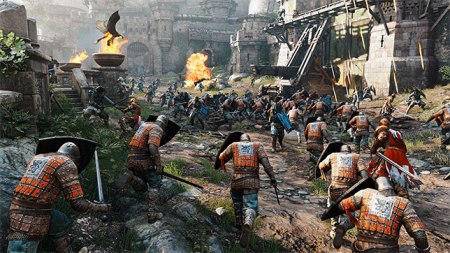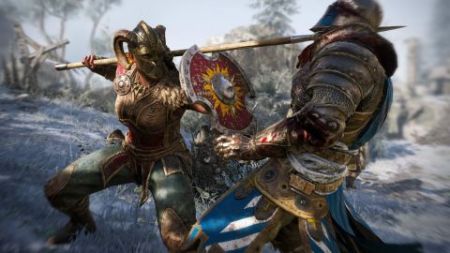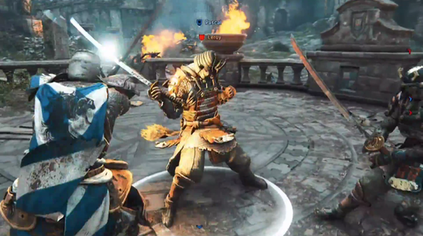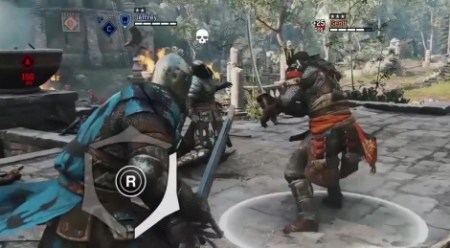Just a Taste: For Honor
/I've always had a love-hate relationship with fighting games. The feeling of mastering a fighter's moveset and the tension of a match, trading blows and counters, is intoxicating, but the hours it takes to memorize button inputs and fighting games' often complicated timing makes the experience tedious and frustrating. For Honor is a fighting game for people like me; it's intuitive, inviting, and fluid without being overly complicated, but still technical enough to reward mastery and experience. Stack a hefty amount of customization options on top of that, and I'm happy to jump into a melee anytime.
For Honor is easy to pick up. At the core of its combat system are stances which dictate where a hero is blocking or attacking. Simply tilt the right stick up, left, or right to block or attack from that direction. This alone feels unique, intuitive, and fun, and I had a blast learning how to quickly block and attack from different directions. If an opponent is putting up a particularly stalwart defense, a forceful shove can open him up for an additional attack or directional throw. Quick dodges help create space, and a well-timed button press during a block can open an opponent to deadly counters. Heavy and light attacks add variety and short combo strings for simple offensive tools. This bedrock creates a stable ground for all types of gamers with differing skill levels, making For Honor one of the most accessible fighting games I’ve ever played.
The brilliance of For Honor lies in its technical depth hidden beneath this graceful simplicity. The game’s twelve heroes have slight differences in reach, speed, damage per hit, blocking, and dodging, but also possess short combo chains which are typically similar between heroes of similar types, so picking them up is easy. Some require simply connecting attacks, others attacking after a successful shove or dodge, and then others something special. My favorite hero type thus far, assassins, can’t hold a block indefinitely like others can, but perform a parry when dodging into an opponent’s attack. This parry opens the opponent up to combos that inflict bleeding damage over time. I love dominating the battlefield with the assassin’s advanced mobility, moving in quickly, parrying attacks, causing bleed damage, and quickly rushing out of range. Even better, it didn't take me hours of practice to feel like I've mastered the class; I'm competitive and confident after just a few matches.
When players find they like a class, they can use steel, the game's currency, to unlock a plethora of customization and equipment options. Colors, paint patterns, material, engravings, and symbols can be applied to every piece of equipment independently, so making a warrior stand out is easy and fun. Find a piece of equipment that benefits the stat you want but its model looks aweful? You can change it to look like another piece of equipment you find particularly sexy. I was surprised at the variety and freedom in altering the appearance of my fighters, and getting new equipment to alter stats adds a fun layer of strategy.
Game modes are fun, albeit limited. Duel and Brawl offer tense one-on-one and two-on-two matches, respectively, and four-on-four Deathmatch is a fun, if chaotic, slugfest. Domination shines as a unique addition for a fighting game, challenging two four player teams to control three control points. Weak AI soldiers from each side fight over a central point, drifting back and forth across the field as players destructively dive into the crowds and duel amongst the masses. The resulting tug-of-war is loads of fun without being overly complicated, and the action still focuses on tense duels within capture points. All these modes are fun, but might grow repetitive for some players, especially since the number of maps seems limited. More modes would bring some exciting variety to the table, like a multi-stage match of defenders versus attackers similar to Battlefield 1's Operations mode.
Performance in these matches contributes to an ongoing war between the three factions--Templar, Vikings, Samurai--represented by a map with three fronts. As players participate in matches, they earn war assets for their faction that can be contributed to defending or attacking territories along each front. The war progresses in rounds, which pass after several days, and the war's outcome is determined in ten weeks. The winning side is awarded gear and other prizes, then the war starts all over again. I like the Risk-esque look to the war, and it feels nice to contribute to something bigger between matches, though it's hard to come to any conclusions as I've not earned anything from it yet.
I've had a lot of fun with my relatively short time in For Honor so far, and I typically fail horribly with online fighting games. Controls and concepts are easy to grasp, different heroes are fun to master, and customization is creative. It'll take more time to see if the limited maps and modes grow stale, but for now, I'm loving the experience.






